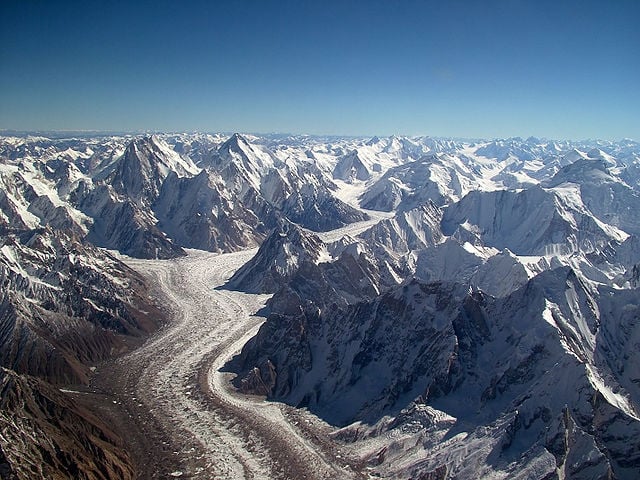Scientists worldwide are trying to crack the mystery of the ‘Karakoram anomaly’ – its glaciers are not only stable but also appear to be gaining mass or ‘expanding’ while most other Himalayan glaciers showing signs of losing ice and are shrinking.
Sarah Kapnick, a postdoctoral research at Princeton University, and colleagues tried to understand snow and rainfall patterns in Karakoram and two neighbouring regions, the central Himalayas, and south-eastern Himalayas/Tibetan plateau.
They combined observations from stations in Pakistan with a global climate model with a 50-kilometre horizontal resolution, higher than that of models studied in the latest fifth assessment report of the Intergovernmental Panel on Climate Change (IPCC).
Most snow and rain in the Karakoram area of the high-mountain region of Asia falls during the winter months, whereas in nearby mountain ranges, monsoon-driven summer precipitation dominates, their study reports in Nature Geoscience. It says the unusual pattern could be protecting the glaciers from melting due to global warming.
So far, the remote location, complex terrain, and multi-country fabric in the high mountains of Asia have made it difficult to maintain longer-term monitoring systems of individual weather factors that can influence glacial change.
The few available studies of observed changes in the region “are often contradictory, merely report observed trends without significance, and provide an incomplete picture due to their lack of full spatial and temporal coverage,” the paper says.
Additionally, the scarcity of long-term climate stations at high altitudes, where most of the snowfall occurs, leads to a reliance on temperature and precipitation observations at low heights, leading to lower estimates.
The new model developed by the US National Oceanic and Atmospheric Administration’s Geophysical Fluid Dynamics Laboratory in Princeton, helps overcome some of these limitations. It “provides a unique opportunity to explore regional climate change over the Karakoram,” Kapnick told thethirdpole.net. The team tried to study changes in weather components, such as temperature, total precipitation, rainfall and snowfall.
“What we find is that unlike over the Himalayas where snowfall is declining, the Karakoram has a stable amount of snowfall since 1861 and projected stable snowfall into the future (through 2100),” she said.
The geographic location and height of the Karakoram mountains provides a unique hydrologic seasonal cycle which depends more on moisture and temperature from winter westerly winds and is influenced by initial cooler summertime temperatures despite similar elevations elsewhere in the Himalayas. This makes Karakoram less sensitive to climate warming than the rest of high-mountain Asia.
Temperatures during the winter months do not increase above freezing, which means snowfall does not decrease due to temperature, Kapnick explained. In fact, total precipitation increases during the winter, which results in increasing snowfall, she said.
This is unlike the other two regions studied, which receive most of their total rain and snow during the summer months when the temperatures are above freezing, leading to snowfall losses.
Kapnick said that the research “highlights the need to look at how the seasonal cycle can affect annual climate change signals. Without breaking the changes down to the monthly scale, it is difficult to understand why the Karakoram exhibits stable snowfall levels, whereas the rest of the Himalayas exhibit negative snowfall during our climate change experiments.”
“In the future, snowfall will continue to be stable, suggesting glacier change (if it happens) will be caused by other factors.”
Kapnick said that the researchers have not directly studied the implications for water flow from the glaciers. But, “It would be interesting to look at changes in the regional hydrology and use the model output to drive a glacier model.”
Contradictory findings
The findings of this study, however, do not tally with those of some other experts working on the Karakoram glaciers.
For example, Kenneth Hewitt, professor emeritus at the department of geography and environmental studies at Wilfred Laurier University, Waterloo, Ontario, says that almost half the nourishment of glaciers in the upper Indus basin is from high-altitude summer snowfall.
“The impression from valley weather stations supports the idea of dominant winter precipitation, but they are not representative of conditions in the glacial zone,” says Hewitt. He has collected data from 4,000 to 6,000 metres on Biafo glacier and nearby basins. Hewitt says his data is supported by countless summer expeditions to the high Karakoram, and Chinese work on the north side.
“It means that the upper Indus glaciers have neither a subtropical winter regime, as in the Pamir and Caucasus, nor a summer regime as further east in the greater Himalaya, but an all-year regime. This has major implications for possible consequences of global climate change.”
According to Hewitt, in the past two decades, summer snowfall and cloudiness in higher mountains seem to be major factors in retarding or preventing glacier mass reduction in the Karakoram.
